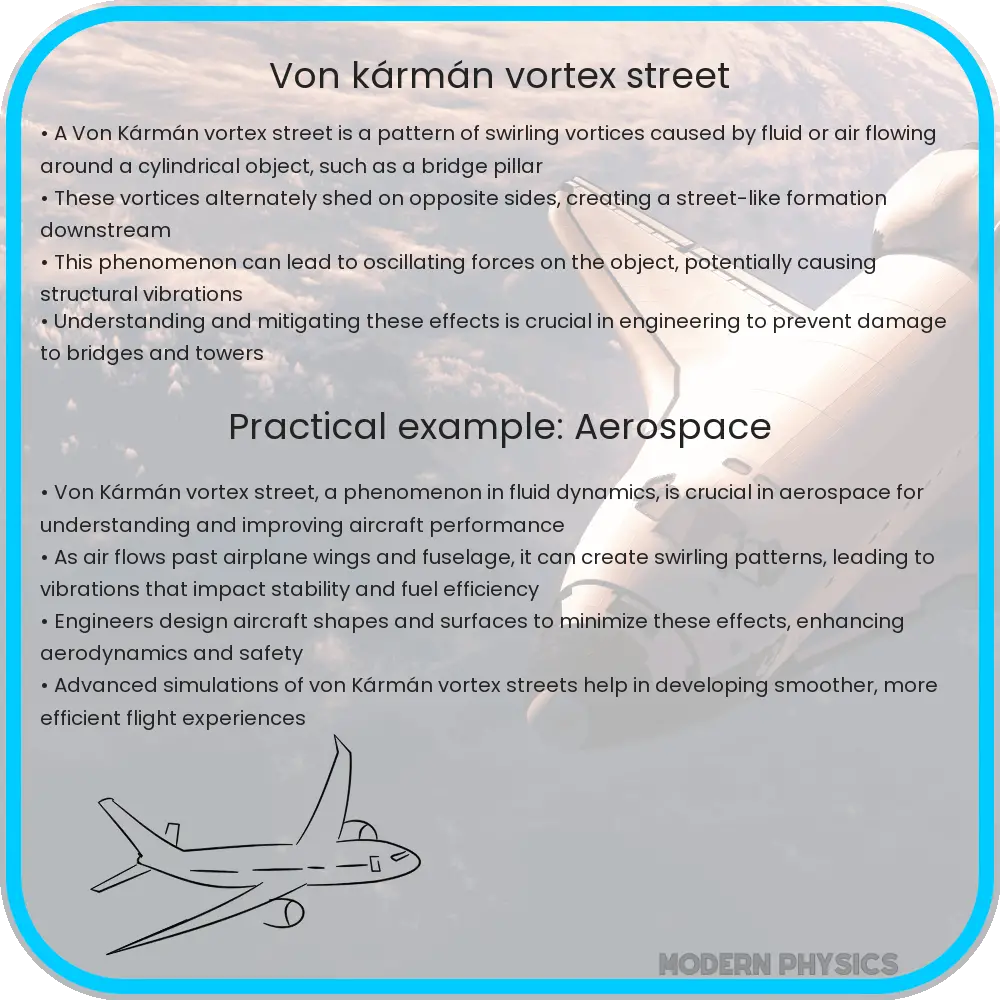Explore the dynamics of the Von Kármán Vortex Street, its impact on engineering, environmental science, and energy innovations.

Understanding the Von Kármán Vortex Street
The Von Kármán Vortex Street is a captivating and complex phenomenon observed in fluid dynamics. Named after Theodore von Kármán, a Hungarian-American physicist, it describes a repeating pattern of swirling vortices caused by a flowing fluid, like air or water, moving past a cylindrical object. This object could be anything from a bridge pier to a tall building. The dynamics of this phenomenon are not just visually striking, but also critically important in the fields of engineering, meteorology, and environmental science.
The Dynamics Behind the Vortex Street
At the heart of the Von Kármán Vortex Street is the concept of fluid flow around an obstacle. When a fluid such as air or water flows past a blunt body, like a cylinder, the fluid layers at the surface of the object slow down due to viscosity. This creates a boundary layer. As the flow continues, this boundary layer separates from the object, and the flow of fluid becomes turbulent on the downstream side. This turbulence is characterized by a series of alternating vortices, which form the distinctive street-like pattern.
Patterns and Characteristics
The pattern of the vortices is highly dependent on a dimensionless number in fluid dynamics known as the Reynolds number (Re). This number is calculated using the formula: Re = ρuL/μ, where ρ is the fluid density, u is the flow velocity, L is the characteristic length (like the diameter of the cylinder), and μ is the dynamic viscosity of the fluid. The Reynolds number determines whether the flow is laminar (smooth) or turbulent. In the case of the Von Kármán Vortex Street, the flow is turbulent and the pattern of vortices is formed at a specific range of Reynolds numbers, typically between 40 and 1000.
Analysis and Practical Implications
Analyzing and understanding the Von Kármán Vortex Street is crucial for several practical applications. In engineering, it helps in designing structures that can withstand or minimize the impact of these forces. For instance, tall buildings and bridge piers are often designed considering the vortex shedding to prevent structural fatigue and resonant vibrations. In meteorology, the pattern can be observed in cloud formations and is essential for weather prediction and understanding atmospheric dynamics. Additionally, in environmental science, understanding vortex streets can aid in studying pollutant dispersion and ecosystem dynamics in water bodies.
Advanced Research and Applications
Recent advancements in computational fluid dynamics (CFD) have significantly enhanced our understanding of the Von Kármán Vortex Street. Scientists and engineers now use sophisticated models to simulate and study these vortex patterns under various conditions. These simulations are crucial in optimizing the design of various structures, such as offshore platforms, to withstand vortex-induced vibrations. Additionally, in the field of renewable energy, researchers are exploring ways to harness energy from these vortices, potentially leading to innovative wind turbine designs.
Environmental Impact and Monitoring
The study of the Von Kármán Vortex Street also plays a vital role in environmental monitoring. For instance, satellite imagery often captures these vortex patterns formed in the wake of islands in ocean currents. These images help scientists understand oceanic flow patterns and their impact on climate and marine life. Similarly, the monitoring of vortex streets in rivers can provide valuable data for managing water resources and predicting flooding.
Educational and Practical Significance
The Von Kármán Vortex Street is not only a subject of professional research but also serves as an excellent educational tool for students in physics and engineering. Its visual and dynamic nature helps in comprehending complex fluid dynamics principles. In practical scenarios, understanding this phenomenon is essential for aeronautical design, where the vortices generated by aircraft wings can impact the aerodynamics and safety of aircraft.
Conclusion
In conclusion, the Von Kármán Vortex Street is a fascinating and multifaceted phenomenon that intersects various disciplines, from engineering to environmental science. Its study provides insights into fluid dynamics, offering critical information for designing stable structures and understanding environmental processes. As technology advances, our ability to analyze and utilize this phenomenon continues to grow, promising new developments in areas like renewable energy and environmental conservation. The Von Kármán Vortex Street, thus, stands as a testament to the intricate and beautiful patterns found in nature, and the endless possibilities they present for human innovation and understanding.
